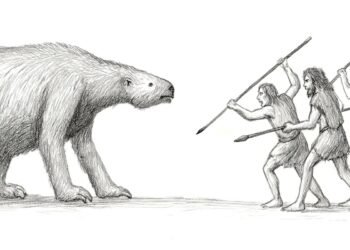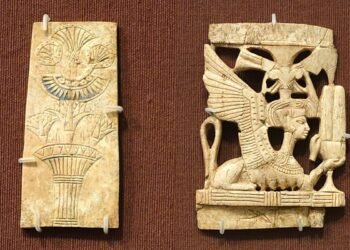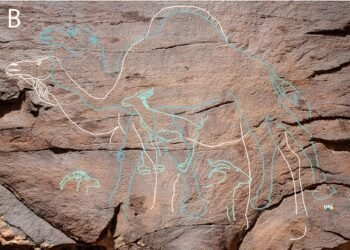A research team led by Columbia University historian Richard Bulliet, along with engineers Lee Alacoque from the University of Illinois Urbana-Champaign and Kai James from Georgia Institute of Technology, provides a compelling theory on the origin of the wheel.

Their findings point to ancient copper miners in the Carpathian Mountains as the creators of the first wheeled devices, specifically for transporting ore. The study’s insights, supported by computational modeling, challenge conventional theories about the wheel’s invention, previously linked to the potter’s wheel in Mesopotamia around 4000 BCE.
Bulliet and his colleagues used design science and computational mechanics to explore how miners may have adapted simple rollers—logs stripped of limbs—to gradually transform into wheel-and-axle systems suitable for narrow mine tunnels. This study suggests that the unique mining environment, with its tight and winding paths, exerted evolutionary pressures on the technology, prompting a gradual shift from basic rollers to a more advanced, maneuverable wheel-and-axle system.
In their model, the researchers mapped out three critical stages in the evolution of the wheel. Initially, rollers were grooved to prevent ore-laden boxes from slipping off. This modification allowed workers to avoid constantly repositioning rollers along the transport path, thus simplifying the hauling process. The second innovation involved widening the ends of these grooved rollers, which led to a rudimentary axle capable of accommodating a single or double set of wheels.

Over time, miners found ways to improve this design, attaching wheels independently to axles—a refinement that enhanced maneuverability and allowed for better navigation over rough terrain. According to the researchers, this progression unfolded over approximately 500 years.
This gradual evolution, according to the study, reflects a nuanced view of technological development, emphasizing trial, adaptation, and environmental influence rather than the sudden invention often portrayed in popular accounts. “Our findings demonstrate the critical role that environmental factors played in the creation of wheeled technology,” Bulliet and his team explain, noting that these evolutionary steps made it possible for the wheel to address practical challenges specific to mining, such as friction reduction and efficient load movement within confined spaces.

The Carpathian Mountains provide additional archaeological evidence supporting the mining theory. Excavations in the region have uncovered over 150 clay models of four-wheeled carts, dating to approximately 3600 BCE and associated with the Boleráz culture. Remarkably, these miniature carts likely served as drinking vessels, indicating a cultural familiarity with wheeled structures. These artifacts, according to the researchers, resemble small wheeled baskets that miners would have used to move ore, hinting at a practical origin for the design.
The Copper Age setting in the Carpathians adds another layer of support to the theory. As copper extraction grew increasingly challenging in this area, efficient methods for transporting heavier loads of ore would have been essential. The study also cites examples of wheeled artifacts from adjacent regions and cultures, such as the Ljubljana Marshes wheel from Slovenia, dated between 5,100 and 5,350 years old, as well as wheeled objects from North Africa and Asia, all highlighting the widespread impact of wheeled technology in early human societies.

By replicating early designs in a virtual environment, the authors assessed stress distribution and elastic responses, demonstrating how grooves in rollers could reduce friction and improve transport efficiency within a mine’s narrow confines. “This scientific approach allows us to connect ancient engineering choices to practical advantages in an unprecedented way,” they note, suggesting that a similar methodology could help unravel other technological mysteries from prehistory.
The study reshapes our understanding of the wheel’s origins, suggesting that it was not the invention of any one culture or individual but rather the result of collaborative efforts shaped by environmental pressures and adaptive problem-solving.























I LOVE finding out about ancient times!!
So there is a continuum from tinkers through to thinkers. Corollary: loss of manufacturing leads to a loss of tinking ability, impeding progress.
True. Thermodynamics was only worked up in the 19th century—a triumph of human thought—under the impetus of optimizing the practical steam engine, whereas centuries of idle scholasticism produced—scholasticism.
It’s a very plausible theory of the evolution of the wheel, although they’re not really presenting any solid evidence. What kind of wheeled contraption was used to transport megalithic stones (world-wide) that often weighed hundreds of tons? And often very many kilometers from the quarry sites. These megalithic sites often form the foundations of much later construction efforts (i.e. Baalbek Lebanon and the Roman Temple of Jupiter). I look forward to any new evidence that sheds light of mans earliest construction efforts with megalithic stones and polygonal stone construction methods.
Where possible, many were moved by sea, rivers and canals, of which many no longer exist now but which can be still found and traced using modern methods. Often it is found that large rivers have also moved from their original location/source, but on finding where these were they are often right next to large buildings/pyramids etc that then explain how material would have reached there in ancient times.
I find it fascinating that the wheel was independently invented at least twice within a few thousand years – in Europe and Mesoamerica – yet never showed up during the tens of thousands of years of human civilization before that. Same thing with agriculture and those massive stone structures – suddenly civilizations all over started figuring out how to move huge rocks around.
(And no, I’m not going all ancient aliens here – it’s just something interesting I noticed. Maybe there’s a simple explanation that archaeologists know all about, but as someone who just finds this stuff interesting, the timing seems pretty wild.)
If they have evidence that the wheel existed in north Africa then weren’t wheels used for transport of 80ton blocks in building the pyramids? Perhaps the wheels weren’t found in northern Africa anywhere near Egypt.